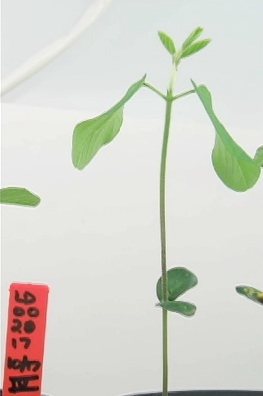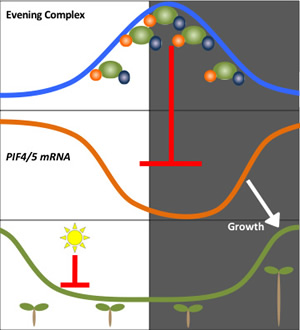Biologists Discover an 'Evening' Protein Complex That Regulates Plant Growth
July 13, 2011
By Kim McDonald

Soybeans grow in spurts just before dawn. This time-lapse video shows a soybean seedling sprouting over several days.
Video Credit: UC San Diego
Farmers and other astute observers of nature have long known that crops like corn and sorghum grow taller at night. But the biochemical mechanisms that control this nightly stem elongation, common to most plants, have been something of a mystery to biologists–until now.
In this week's early online publication of the journal Nature, biologists at the University of California, San Diego report their discovery of a protein complex they call the "evening complex" that regulates the rhythmic growth of plants during the night. More importantly, the biologists show how this protein complex is intricately coordinated through the biological clock with the genes that promote stem elongation in a way that could enable plant breeders to engineer new varieties of crops that grow faster, produce greater yields of food or generate more biomass per acre of land for conversion into biofuels.
"This discovery gives us a molecular understanding of how the biological clock is regulating cyclic growth in plants," said Steve Kay, dean of UC San Diego's Division of Biological Sciences, who headed the research effort. "And it instantly gives us a handle on how we might manipulate and control plant yield or biomass deposition."
While most people assume that plants grow at a slow and steady rate throughout the day and night, Charles Darwin and others more than a century ago observed that they actually grow in spurts late at night, with plant stems elongating fastest in the hours just before dawn.
"Plants actually grow rhythmically," said Kay. "Some plants, like sorghum, have the ability to elongate a centimeter or more each night."
The UCSD biologists initially focused their attention on three genes from a tiny mustard plant called Arabidopsis, which is used by geneticists as a laboratory model for plants. When they are disabled by mutations, these three genes disrupt the plant's biological clock and promote both stem elongation and early flowering.
"These three genes have been of intense interest because the loss of function in each one of them kills the biological clock, causes a long hypocotyl, or juvenile stem, and tends to cause early flowering," said Kay. "We thought that maybe their function was related. So this investigation was basically started to figure out what these three genes do."
The answer to that seemingly simple question took the biologists more than six years to disentangle. Their efforts were led by three postdoctoral fellows in Kay's lab: Dmitri Nusinow, Anne Helfer and Elizabeth Hamilton.
"Circadian clocks control the timing of an extraordinary variety of developmental and physiological processes in humans and other species, but figuring out how they do this is tough," said Laurie Tompkins, who oversees biological clock grants at the National Institutes of Health's National Institute of General Medical Sciences, which funded the research. " Arabidopsis is ideal for this sort of analysis, since researchers can use a variety of sophisticated genetic and biochemical tools to study molecular interactions at different times of day and then easily observe the tiny plant's development."

Photo Credit: Yhew Pongsawakul
Because the three genes–Early Flowering3 (or ELF3), ELF4 and LUX–have biological activities that peak in the early evening, the UCSD biologists wondered if the three genes acted together in a protein complex. Through a series of experiments in yeast cells, they determined the three genes produced proteins that did interact with one another, but in a specific way. ELF3 served as a docking protein that brought together ELF4 and LUX, but the latter two did not interact with each other without ELF3's help.
This protein complex was dubbed the "evening complex" by the UCSD scientists, who verified in Arabidopsis that not only did the biological activities of the three components of this protein complex peak in the evening, but so did the formation of the evening complex itself.
The researchers then sought to answer the question of what the physiological role of this protein complex could be in plants. One main clue pointed them in the right direction: When any one of the three genes controlling this protein complex is disabled, plants end up with grossly elongated stems.
"This protein complex is clearly acting like the brakes on growth," said Kay. "So when we mutate any one of these genes the plants elongate much more."
In another set of experiments, the researchers demonstrated that the evening complex puts the brakes on the activity of two genes in plants–PIF4 and PIF5–that are important in promoting plant growth.
"What we show in our paper is that the evening complex binds to the promoters of PIF4 and PIF5 and, at the end of the day and through the early part of the night, prevents the plants from growing," said Kay. "And when the levels of the evening complex begin to drop, PIF4 and PIF5 are expressed and drive plant expression programs that support stem elongation, and the brakes on plant growth are taken off."
In this new model of plant growth developed by the scientists, PIF4 and PIF5 control the gas pedal that activates plants to grow, while the three genes that produce the evening complex act as the brakes and work with the plant's biological clock to permit the most rapid growth in the late evening and early morning hours.
"Nobody knew how this cyclic regulation of plant growth worked on a molecular level, but this must be one of the major mechanisms," said Kay. "This really gives us a molecular understanding of how the biological clock is regulating cyclic growth in plants."
Why plants time their diurnal cycle to grow most rapidly late at night and in the wee hours of the morning is still a mystery, but Kay suspects it could be when resources are most available since plants store what they produce from photosynthesis during the day as starch, then break that starch and protein down at night to make them available for growth.

UCSD biologists discovered the evening complex peaks in the early evening, causing stem elongation to occur later in the night.
Photo Credit: UC San Diego
"Plants have to coordinate their growth with the availability of resources," he said. "There's really no advantage for these plants just to get bigger and bigger if they're not coordinating their metabolic resources, which come cyclically with photosynthesis each day. So plants grow rhythmically presumably to coordinate growth with available metabolic resources."
As scientists gain a better understanding of these plant growth control mechanisms, the potential commercial applications to agriculture could be as broad as they are significant. The discovery of the mechanisms of the evening complex should eventually provide plant geneticists with a new way to optimize the growth of crops so they can produce more food or more biomass per acre for biofuel production.
"What this discovery tells us is that the circadian clock is controlling tens of millions of tons of biomass deposition every night in the United States that could be used for bioenergy," said Kay. "Now that we understand what the gas and the brakes are in controlling plant growth, we can manipulate those to maximize biomass deposition. We could do it by putting the gas on more or putting the brakes on less or probably in a more sophisticated way by combining the gas and brakes so that we allow the plant to maximize available nutrients, which will allow it to maximize biomass deposition. This could be a way to optimize plant growth for a particular environment where we don't want to add additional nutrients to the soil."
Kay said another totally unrelated application for the evening complex could be in making plants, particularly food crops, more tolerant to cold temperatures or freezing.
"When you make mutations to these genes, the plants are less tolerant to freezing and low temperatures," he said. "So we think the evening complex is likely to have a role in cold tolerance and that's something else we're going to be investigating."
Media Contact- Kim McDonald (858) 534-7572; kmcdonald@ucsd.edu
- Steve Kay (858) 534-4281; skay@ucsd.edu
